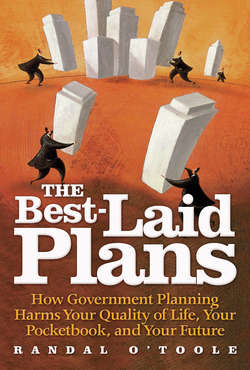Читать книгу The Best-Laid Plans - Randal O'Toole - Страница 32
На сайте Литреса книга снята с продажи.
Part Three Land-Use Planning
ОглавлениеA man is not a whole and complete man unless he owns a house and the ground it stands on.
—Walt Whitman1
The latest fad among land-use planners is to write 50-year plans for entire urban regions housing millions of people. As noted in chapter 6, some believe that such regional plans should be “drawn with such precision that only the architectural detail is left to future designers.”2 How much effort would be needed to accomplish this?
An urban area of a million people may have a million parcels of land, each suitable for dozens of different uses. Each person in the region may have a different idea about the best use of each parcel, and picking any particular use for a given parcel will influence the best possible uses of other nearby parcels. This means that the number of data needed to find the optimum use of each parcel in the region is literally in the quadrillions. This is far beyond the ability of anyone to collect, much less comprehend.
In response, planners simplify. Too often, that simplification is not limited to the models planners use to understand what they are planning. Instead, it extends to actually simplifying reality. Oregon planners, for example, believe that the only legitimate lifestyles are urban and rural. State planning rules prohibit anyone from building a house on their own land in the 95 percent of the state that is zoned rural unless they own at least 160 acres, actually farm the land, and earned $40,000 to $80,000 (depending on land productivity) farming it in two of the past three years. This rule was needed, said the state, to prevent “lawyers, doctors, and others not really farming [from] building houses in farm zones.”3
Planning a complex regional economy becomes more feasible once planners simplify the economy to just a few possible lifestyles. But that does not mean that the economy planners get will be as productive or desirable as one that is allowed to evolve with minimal planning and regulation.
New Urban design, the idea of high-density, mixed-use developments, often located on transit lines, is another simplification. Though planners deny it, such so-called transit-oriented developments have become a one-size-fits-all solution to any urban problem.
• Do you have a decaying warehouse district near your downtown? Build a transit-oriented development such as Portland’s Pearl District.
• Do you have a thriving suburb where most people drive to most places they go? Build a transit-oriented development such as the Round in the Portland suburb of Beaverton.
• Do you have an undeveloped greenfield inside the urban-growth boundary whose owner is eager to subdivide? Build a transit-oriented development such as Orenco near the Portland suburb of Hillsboro.
• How about a town so small it does not even have any regular transit service? Build a high-density, mixed-use development such as one recently proposed in my current hometown of Bandon, a town of 3,000 people.4
The simplifications planners make may change over time. In the 1950s and 1960s, planning was all about urban renewal: slum clearance and construction of high-rise luxury housing or high-rise low-income housing projects. In the 1990s and early 2000s, planning focuses on suburban renewal: redevelopment of suburbs to higher densities. Perhaps in another couple of decades planning will turn to exurban renewal, with planners attempting to impose their visions on the increasing number of telecommuters who choose to live in rural areas. But in all these cases, the plans are based on planners’ simplified notions of how people should live rather than on how people actually live.
